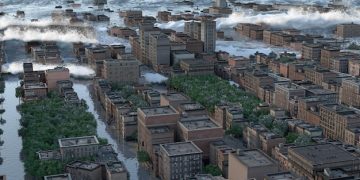Climate Change’s US Economic Impact: Costs & Solutions

The profound and increasingly tangible effects of climate change pose significant financial burdens and risks to the U.S. economy, necessitating proactive strategies for mitigation and adaptation to safeguard economic stability and future prosperity.
The intricate relationship between environmental degradation and economic stability is becoming ever more apparent, with the impact of climate change on the US economy: a look at the costs and potential solutions emerging as a critical, multifaceted challenge. From extreme weather events to long-term shifts in agricultural productivity and resource availability, the American economy faces escalating vulnerabilities that demand immediate and strategic attention, extending far beyond abstract environmental concerns into concrete fiscal realities.
The Mounting Economic Toll of Extreme Weather Events
The United States has experienced a dramatic increase in the frequency and intensity of extreme weather events over the past few decades, a trend directly linked to a changing climate. These events, ranging from devastating hurricanes and prolonged droughts to severe wildfires and historic floods, impose substantial and growing economic costs. Unlike localized disruptions, these events often trigger cascading failures across multiple economic sectors, from agriculture and infrastructure to tourism and insurance. The financial burden extends far beyond immediate property damage, encompassing lost productivity, increased healthcare costs, and long-term recovery efforts that can strain state and federal budgets for years.
Infrastructure Vulnerability and Costs
American infrastructure, much of it aging, was largely built without anticipating the current scale of climate-related disruptions. Roads, bridges, power grids, and water systems are increasingly vulnerable to damage from rising sea levels, intense precipitation, and extreme heat. Repairing and bolstering this infrastructure against future climate impacts represents an immense financial undertaking.
- Coastal Resiliency: Protecting vital coastal infrastructure from storm surges and rising sea levels demands costly investments in seawalls, natural barriers, and elevated structures.
- Wastewater Systems: Increased rainfall and flooding overwhelm existing drainage and wastewater treatment facilities, leading to pollution and costly upgrades.
- Energy Grids: Extreme temperatures stress power grids, leading to blackouts, while wildfires threaten transmission lines, necessitating grid modernization and hardening.
These infrastructural challenges highlight a critical dilemma: the cost of inaction far exceeds the investment required for adaptation and resilience, yet funding mechanisms often lag behind the urgent need for comprehensive overhauls. The interplay between climate science and urban planning is becoming increasingly vital to mitigate future economic shocks.
Agricultural Losses and Food Security
Agriculture, a cornerstone of the US economy, is profoundly susceptible to climate change. Shifting precipitation patterns, increased temperatures, and more frequent extreme weather events directly impact crop yields and livestock health. Droughts devastate harvests in key agricultural regions, while floods can wipe out entire planting seasons. This volatility not only affects farmers’ livelihoods but also has ripple effects on food prices, supply chains, and ultimately, consumer spending. The resilience of the agricultural sector is crucial for national food security and economic stability. Innovative farming practices and drought-resistant crops are becoming essential, yet scaling these solutions across vast agricultural lands presents its own set of economic and logistical hurdles. The long-term implications for global food markets, given the US’s role as a major food exporter, are also considerable.
The direct and indirect costs associated with extreme weather events underscore the urgency of addressing climate change as an economic imperative. The financial fallout from these events is not merely a budgetary line item but a fundamental challenge to economic growth and stability. As these events escalate in frequency and severity, the ability of communities and governments to recover and rebuild will be continually tested, potentially leading to systemic economic vulnerabilities.
Long-Term Economic Shifts and Resource Scarcity
Beyond immediate disaster recovery, climate change induces gradual yet profound shifts in the availability and quality of essential resources, leading to significant long-term economic restructuring. These shifts impact industries ranging from tourism and fisheries to manufacturing and energy, necessitating adaptation strategies that often come with substantial economic costs or opportunities for innovation. The intricate web of supply chains and global markets means that resource scarcity in one region can have ripple effects worldwide, affecting prices, trade balances, and geopolitical stability. Understanding these slow-moving economic transformations is crucial for strategic planning and informed policy-making, helping to minimize disruption and maximize resilient growth.
Water Stress and its Economic Implications
Water scarcity, exacerbated by changing precipitation patterns and increased evaporation rates, is emerging as a critical economic constraint, particularly in the western and southwestern United States. Industries reliant on abundant water, such as agriculture, energy production, and even semiconductor manufacturing, face operational challenges and increased costs. Reduced water availability can lead to decreased agricultural output, higher electricity prices due to strained hydropower, and limitations on industrial development.
- Agriculture: Farmers face reduced irrigation allocations, forcing shifts to less water-intensive crops or scale back operations, impacting rural economies.
- Energy Production: Thermal power plants require cooling water, and hydropower generation is directly tied to water levels; scarcity affects energy supply and cost.
- Urban Development: Rapid population growth in water-stressed regions clashes with diminishing supplies, necessitating expensive water management solutions and potentially limiting expansion.
The economic impact of water stress is systemic, affecting everything from property values in drought-stricken areas to the viability of entire regional economies. Investing in water conservation technologies, desalination plants, and improved water infrastructure becomes not just an environmental imperative but an economic necessity.
Impacts on Coastal Economies and Industries
Rising sea levels pose an existential threat to coastal communities and their economies. Millions of Americans live and work in low-lying coastal areas, home to vital ports, tourism industries, and significant real estate assets. Increased tidal flooding, erosion, and storm surges threaten to inundate infrastructure, displace populations, and devalue coastal properties.

The economic implications extend to several key sectors:
- Tourism and Recreation: Beaches erode, coastal ecosystems degrade, and extreme weather events disrupt tourism seasons, affecting local businesses from hotels to fishing charters.
- Real Estate: Property values in flood-prone areas face decline, insurance premiums skyrocket, and mortgages become harder to secure, creating a potential housing market crisis.
- Fisheries: Ocean acidification and warming waters disrupt marine ecosystems, impacting fish stocks and the livelihoods of fishing communities.
Proactive planning, including managed retreat, shoreline protection, and robust flood defenses, is essential but comes with enormous price tags and often contentious social implications. The long-term economic viability of many coastal communities hinges on decisive action.
Long-term economic shifts from climate change are not abstract future problems; they are current economic realities reshaping resource allocation, industrial strategy, and regional development. Businesses and governments that fail to account for these systemic changes risk significant competitive disadvantages and financial instability.
Public Health Costs and Productivity Loss
The nexus between climate change and public health is increasingly undeniable, leading to substantial economic costs through increased healthcare expenditures and diminished labor productivity. Rising temperatures, degraded air quality, and the spread of vector-borne diseases place additional burdens on healthcare systems and workforce capacity, directly impacting economic output and human capital. These health-related economic impacts are often less visibly accounted for than direct property damage but are nonetheless pervasive and significant, affecting individuals, communities, and national productivity.
Heat-Related Illnesses and Occupational Impacts
Rising ambient temperatures pose direct health risks, particularly for outdoor workers and vulnerable populations. Heat strokes, heat exhaustion, and other heat-related illnesses lead to increased emergency room visits, hospitalizations, and, in severe cases, fatalities. For workers in agriculture, construction, and other outdoor professions, extreme heat reduces productivity, necessitates rest breaks, and can even lead to shorter working days or seasons, directly affecting output and earnings.
- Healthcare Burden: Increased heat-related illnesses strain healthcare facilities, leading to higher medical costs and resource allocation shifts.
- Labor Productivity: Workers’ ability to perform physically demanding tasks is reduced, leading to economic losses in sectors heavily reliant on outdoor labor.
- Economic Disparities: Low-income communities and those without access to air conditioning are disproportionately affected, widening health and economic inequalities.
Investing in public cooling centers, revised workplace safety regulations, and urban planning that mitigates urban heat islands can help alleviate some of these pressures, but the underlying issue of rising temperatures persists.
Air Quality Degradation and Respiratory Issues
Climate change contributes to poorer air quality through various mechanisms. Warmer temperatures exacerbate ground-level ozone formation, and longer, more intense wildfire seasons release vast amounts of particulate matter into the atmosphere. These pollutants contribute to a range of respiratory and cardiovascular diseases, including asthma, chronic bronchitis, and heart attacks. The economic costs manifest as increased medical expenses, lost workdays due to illness, and reduced academic performance in children. The impacts are felt most acutely in urban areas and downwind of major wildfire zones.
Spread of Vector-Borne Diseases
Changes in temperature and precipitation patterns expand the geographic range and seasonality of disease vectors like mosquitoes and ticks. This leads to the increased incidence of vector-borne diseases such as West Nile virus, Lyme disease, and potentially new threats like Zika and malaria in previously unaffected areas. The economic consequences include:
- Healthcare Costs: Diagnosis, treatment, and long-term care for these diseases add a significant burden to healthcare systems.
- Productivity Loss: Illness can incapacitate individuals, leading to lost wages and reduced economic output.
- Public Health Interventions: Increased funding is required for surveillance, prevention, and control measures, diverting resources from other public health needs.
The interaction between climate change and public health represents a complex feedback loop that compounds economic challenges. A healthier population is a more productive and resilient population, underscoring the economic rationale for addressing climate change to safeguard public health.
Supply Chain Disruptions and Market Volatility
The globalized nature of modern economies means that climate-related disruptions in one region can trigger cascading effects across international supply chains, leading to market volatility and increased operational costs for businesses. Whether it’s extreme weather hindering transportation, resource scarcity impacting raw material prices, or agricultural failures pushing up food costs, climate change injects an unprecedented level of uncertainty into global commerce. This instability can erode consumer confidence, deter investment, and ultimately dampen economic growth, highlighting the interconnectedness of environmental stability and commercial resilience.
Disruption of Transportation and Logistics
Transportation networks are the arteries of global supply chains, and they are highly vulnerable to climate impacts. Extreme weather events like floods, hurricanes, and heavy snowfalls can shut down ports, close roads, and delay air traffic, leading to significant bottlenecks and increased shipping costs. Rising sea levels threaten coastal infrastructure, including port facilities, while extreme heat can buckle rail lines and limit cargo capacity on airplanes.
The direct result of these disruptions is delayed deliveries, spoiled goods, and higher logistical expenses, which businesses often pass on to consumers in the form of higher prices. This contributes to inflationary pressures and reduces overall economic efficiency. Supply chain managers are increasingly having to factor in climate risks when planning global operations, seeking more resilient routes and diversifying sources, which can add complexity and cost to their strategies.
Impacts on Global Commodity Prices
Climate change significantly influences global commodity markets, particularly for agricultural products and natural resources. Droughts in major grain-producing regions, for instance, can lead to dramatic spikes in wheat or corn prices, affecting food manufacturers, retailers, and consumers worldwide. Similarly, disruptions to energy infrastructure due to extreme weather can cause oil and gas price volatility.
These price fluctuations create uncertainty for businesses that rely on these commodities as inputs, making it difficult to forecast costs and plan production. For consumers, it translates to higher prices for essentials, eroding purchasing power. This volatility can also spill over into financial markets, affecting investors and potentially contributing to broader economic instability.

Increased Insurance Costs and Availability Challenges
The escalating frequency and severity of climate-related disasters have a direct and profound impact on the insurance industry. As losses mount, insurance companies face higher payouts, which inevitably lead to increased premiums for homeowners, businesses, and even municipalities. In high-risk areas, particularly along coastlines and in wildfire zones, insurance coverage may become prohibitively expensive or even unavailable entirely.
This situation creates a significant economic burden for property owners and limits investment in areas deemed too risky. It also shifts more of the financial burden onto public disaster relief funds, straining taxpayer dollars. The long-term viability of communities in climate-vulnerable regions is increasingly tied to the availability and affordability of insurance, making climate risks a fundamental factor in property markets and urban planning. Addressing these issues requires both strong mitigation efforts and innovative risk-sharing mechanisms.
Economic Opportunities in the Green Transition
While climate change presents significant economic challenges, it also catalyzes substantial opportunities for innovation, job creation, and economic growth in the transition to a low-carbon economy. Investing in renewable energy, energy efficiency, sustainable agriculture, and climate-resilient infrastructure not only mitigates environmental risks but also fosters new industries, enhances competitiveness, and creates a more sustainable and equitable economic future. The shift towards green technologies and practices can unlock new markets, drive technological advancements, and position the United States as a global leader in the emerging green economy, transforming challenges into drivers for prosperity.
Growth of Renewable Energy Sector
The shift away from fossil fuels towards renewable energy sources like solar, wind, and geothermal power is a cornerstone of climate action and a significant economic opportunity. The renewable energy sector has seen rapid growth in recent years, creating millions of jobs in manufacturing, installation, operation, and maintenance. Investments in renewable energy infrastructure also stimulate local economies and enhance energy independence.
- Job Creation: The solar and wind industries are among the fastest-growing job sectors, offering diverse employment opportunities from engineering to construction.
- Technological Innovation: Research and development in renewables drive breakthroughs in energy storage, grid management, and smart technologies, fostering a competitive advantage.
- Energy Security: Reducing reliance on volatile global fossil fuel markets enhances national energy security and stabilizes energy costs over the long term.
Government incentives, private investment, and declining technology costs are accelerating this transition, positioning renewables as increasingly competitive alternatives to traditional energy sources and driving economic growth.
Job Creation in Green Industries
The green transition extends beyond just renewable energy, encompassing a wide array of industries focused on sustainability and climate resilience. This includes sectors like energy efficiency, sustainable agriculture, waste management, green building, and environmental consulting. As the demand for sustainable products and services grows, so too does the need for a skilled workforce to design, implement, and maintain these solutions.
- Energy Efficiency: Jobs in retrofitting buildings, manufacturing efficient appliances, and developing smart grid technologies.
- Sustainable Agriculture: Roles in organic farming, vertical farming, sustainable land management, and agricultural technology development.
- Waste Management & Circular Economy: Jobs in recycling, composting, and developing systems that minimize waste and maximize resource utilization.
These emerging green industries represent a significant source of future employment and economic diversification, requiring investments in education and vocational training to build the necessary human capital.
Investment in Climate-Resilient Infrastructure
Adapting to the unavoidable impacts of climate change requires significant investment in resilient infrastructure. This demand creates opportunities for engineering, construction, and technology firms specializing in climate-proofing existing assets and building new, sustainable infrastructure. Projects include developing advanced flood defenses, upgrading stormwater systems, creating adaptive transport networks, and enhancing natural ecosystems that provide protective services. These investments not only safeguard communities and economic assets but also create jobs and stimulate local economies. The focus on resilience fosters innovation in materials science, urban planning, and civil engineering, leading to new economic advantages and export opportunities for American expertise.
Policy Measures and Economic Solutions
Addressing the economic ramifications of climate change requires a robust framework of policy measures and innovative economic solutions. Governments at all levels, alongside businesses and civil society, must collaborate to implement strategies that both mitigate greenhouse gas emissions and enhance societal resilience to climate impacts. These solutions range from market-based mechanisms and regulatory frameworks to public investments and international cooperation, all designed to steer the economy towards a more sustainable and climate-secure future without stifling growth.
Carbon Pricing Mechanisms
One of the most widely discussed economic tools for climate mitigation is carbon pricing, which assigns a cost to greenhouse gas emissions. This can take the form of a carbon tax or a cap-and-trade system.
- Carbon Tax: Directly imposes a fee on each ton of carbon dioxide emitted, providing a clear economic incentive for businesses to reduce their carbon footprint.
- Cap-and-Trade: Sets a limit (cap) on total emissions, and companies can buy and sell (trade) emission allowances, allowing the market to determine the price of carbon.
Both mechanisms aim to internalize the external costs of pollution, making high-carbon activities more expensive and incentivizing investments in cleaner technologies. While politically challenging, expert analysis suggests carbon pricing is one of the most economically efficient ways to reduce emissions, generating revenue that can be reinvested in green initiatives or returned to citizens.
Incentivizing Renewable Energy and Efficiency
Governments can accelerate the transition to a low-carbon economy through a variety of incentives that support renewable energy development and energy efficiency improvements. These include:
- Tax Credits and Rebates: Financial incentives for individuals and businesses to install solar panels, purchase electric vehicles, or upgrade to energy-efficient appliances.
- Grants and Loans: Funding for renewable energy projects, particularly for research and development of emerging technologies.
- Regulatory Standards: Establishing mandates for renewable energy penetration or setting energy efficiency targets for buildings and vehicles.
These policies reduce initial investment barriers, make green technologies more competitive, and drive consumer adoption, stimulating the growth of the green economy and fostering technological innovation.
Investment in Research and Development
Innovation is key to developing breakthrough technologies that can address climate change more effectively and at lower costs. Significant public and private investment in research and development (R&D) is crucial for:
- Advanced Energy Storage: Improving battery technology and other storage solutions to enable wider integration of intermittent renewable energy sources.
- Carbon Capture and Storage (CCS): Developing scalable and cost-effective technologies to remove carbon dioxide directly from industrial emissions or the atmosphere.
- Climate-Resilient Agriculture: Research into drought-resistant crops, precision agriculture, and sustainable farming practices that can adapt to changing conditions.
These investments not only provide potential solutions to complex climate challenges but also create high-skilled jobs and position the US economy at the forefront of global technological advancements. Robust R&D pipelines are essential for long-term climate resilience and economic competitiveness.
The Role of International Cooperation and Global Markets
Climate change is a global phenomenon, and its economic impacts and solutions inherently transcend national borders. The United States’ economic resilience and its ability to effectively address climate change are inextricably linked to international cooperation, global market dynamics, and synchronized efforts with other nations. Building a sustainable future requires collective action on emissions reduction, shared technological advancements, and collaborative adaptation strategies to ensure a stable global economy.
Global Emissions Reduction Efforts
No single nation, regardless of its economic power, can solve climate change alone. Global emissions reduction efforts are critical to stabilizing the climate system and mitigating the most severe economic risks. The United States, as a major economy, plays a pivotal role in international climate negotiations and agreements, such as the Paris Agreement. Participating in these frameworks and upholding commitments encourages other nations to follow suit, creating a cumulative global impact. Economic benefits arise from coordinated action, as it prevents carbon leakage (where industries move to countries with less stringent environmental regulations) and fosters a level playing field for businesses engaged in the green transition.
Supporting developing nations in their transition to low-carbon economies, through technology transfer and financial assistance, is also crucial. This not only aids global emissions reduction but also opens up new markets for American green technologies and services. The interconnectedness of global value chains means that climate-induced disruptions in one part of the world can have ripple effects on US businesses and consumers, underscoring the economic rationale for global climate stability.
Collaborative Research and Technology Sharing
Accelerating the development and deployment of climate solutions benefits immensely from international collaboration in research and technology sharing. No country has a monopoly on innovation, and pooling scientific expertise and resources can lead to faster breakthroughs in areas like renewable energy efficiency, carbon capture, climate modeling, and climate-resilient infrastructure. Open exchange of knowledge and intellectual property, where appropriate, can rapidly disseminate best practices and cost-effective solutions globally.
This collaborative approach can reduce the overall cost of climate action, allowing solutions developed in one country to be implemented and scaled elsewhere. It also fosters new partnerships and trade opportunities in green technologies, benefiting all participating economies. International scientific cooperation prevents duplication of efforts and ensures that the most promising solutions are identified and advanced efficiently.
Financial Mechanisms and Climate Finance
Addressing climate change, particularly adaptation in vulnerable developing nations, requires substantial financial resources. The concept of climate finance involves wealthier nations supporting less developed countries in their mitigation and adaptation efforts. This is not merely an act of beneficence but a strategic economic investment.
- Risk Reduction: Helping other nations build resilience reduces the likelihood of broader economic instability, mass migration, and humanitarian crises that can have spillover economic effects on the US.
- Market Development: Climate finance can stimulate green markets in developing countries, creating export opportunities for US clean technology firms.
- Global Stability: A more climate-resilient and economically stable world is ultimately more conducive to global trade, investment, and US national interests.
Mechanisms like the Green Climate Fund, bilateral aid, and private sector investments are vital tools in this regard. International financial institutions also play a key role in integrating climate considerations into their lending and investment decisions, influencing global capital flows towards sustainable development.
Adaptation and Resilience Planning: Mitigating Future Risks
Even with aggressive global emission reduction efforts, some degree of climate change and its associated impacts is now unavoidable due to past emissions. Therefore, comprehensive adaptation and resilience planning are critical economic strategies for the United States. This involves developing and implementing measures to reduce the vulnerability of communities, infrastructure, and economic sectors to climate impacts, thereby mitigating future economic losses and ensuring long-term stability. Proactive investment in resilience not only saves money in the long run by reducing disaster recovery costs but also creates a more robust and adaptable economy capable of withstanding future environmental shocks.
Community-Level Resilience Building
Building resilience often begins at the local level, where communities are directly exposed to climate risks. This involves a multi-faceted approach:
- Updated Building Codes: Implementing stricter building codes that account for increasing risks from extreme winds, heavy rainfall, and flooding, making new construction more resilient.
- Nature-Based Solutions: Investing in and restoring natural ecosystems such as wetlands, coastal dunes, and forests, which can act as natural buffers against floods and storm surges.
- Early Warning Systems: Enhancing capabilities for accurate weather forecasting and dissemination of timely warnings to protect lives and allow for preparatory actions for businesses and residents.
Empowering local governments and community organizations with resources and expertise is essential for tailoring resilience strategies to specific local needs and vulnerabilities, fostering stronger local economies.
Infrastructure Adaptation and Hardening
Protecting critical national infrastructure from climate impacts is a massive but necessary undertaking. This involves not just repairing damage but fundamentally redesigning and reinforcing systems to withstand future climate conditions.
- Elevating Structures: Raising roads, bridges, and buildings in flood-prone areas to prevent inundation.
- Grid Modernization: Hardening power grids against extreme weather, integrating distributed renewable energy sources, and developing microgrids to enhance reliability during outages.
- Water Management Systems: Upgrading stormwater drains, expanding reservoir capacities, and investing in advanced water treatment and recycling technologies to ensure water security.
These large-scale infrastructure projects not only protect existing economic assets but also create jobs and stimulate innovation in engineering and construction sectors, contributing to long-term economic growth.
Financial Risk Management and Insurance Innovation
As climate risks escalate, traditional financial mechanisms are being challenged. New approaches to risk management and insurance are emerging, including:
- Parametric Insurance: Payouts are triggered by specific environmental events (e.g., wind speed reaching a certain threshold, rainfall exceeding a certain amount) rather than actual damages, allowing for faster recovery.
- Catastrophe Bonds: Financial instruments that transfer specific climate-related risks from insurers to capital market investors.
- Public-Private Partnerships: Collaborations to develop innovative financing solutions for resilience projects that may be too large or risky for any single entity.
These financial innovations help distribute climate-related financial burdens, encourage proactive risk reduction, and ensure that capital remains available for recovery and redevelopment, strengthening overall economic stability in the face of escalating climate impacts. Proactive financial planning is as crucial as physical infrastructure for building long-term resilience.
| Key Economic Area | Brief Impact or Solution |
|---|---|
| ⛈️ Extreme Weather | Increased infrastructure damage and high recovery costs. |
| 🌱 Agriculture & Resources | Yield volatility, water scarcity, and impacts on food security. |
| ⚕️ Public Health | Higher healthcare costs and reduced labor productivity. |
| 💡 Green Economy | New job creation and significant investment opportunities. |
Frequently Asked Questions About Climate Change’s Economic Impact
Climate change directly impacts the US economy through increased costs from extreme weather events, such as hurricanes and wildfires, leading to infrastructure damage, agricultural losses, and higher insurance premiums. It also causes long-term economic shifts, like water scarcity and coastal property devaluation, affecting multiple sectors and regional economies. These financial burdens are becoming increasingly substantial.
The public health-related economic costs include increased healthcare expenditures due to heat-related illnesses, worse air quality leading to respiratory issues, and the spread of vector-borne diseases. These health challenges result in lost workdays, reduced labor productivity, and strain on healthcare systems, ultimately diminishing overall economic output and human capital across various industries.
Yes, climate change creates significant economic opportunities in the green transition. Investments in renewable energy, energy efficiency, sustainable agriculture, and climate-resilient infrastructure foster new industries, create millions of jobs, and drive technological innovation. This shift can position the US as a global leader in the emerging green economy, enhancing competitiveness and fostering sustainable growth.
Government policies are crucial for addressing climate change’s economic impacts. They can implement mechanisms like carbon pricing to incentivize emission reductions, offer tax credits and grants for renewable energy and energy efficiency, and invest in research and development for new climate solutions. These policies aim to redirect economic activity towards more sustainable practices and reduce future risks.
International cooperation is vital because climate change is a global issue. Coordinated emissions reduction efforts, collaborative research, and technology sharing prevent carbon leakage and accelerate innovation, benefiting all economies. Financial mechanisms and climate finance also help stabilize global markets and reduce risks that could otherwise have adverse spillover effects on the US economy, fostering overall global stability.
Conclusion
The economic ramifications of climate change are no longer a distant threat but a present reality for the United States, manifesting as escalating costs from extreme weather, long-term resource shifts, and public health burdens. However, this profound challenge simultaneously presents a transformative opportunity for economic restructuring and innovation. By strategically investing in renewable energy, resilient infrastructure, and sustainable practices, alongside implementing robust policy frameworks and fostering international cooperation, the US can transition to a more secure, competitive, and prosperous low-carbon economy. The path forward demands foresight, significant investment, and a collaborative spirit to mitigate risks and harness the immense potential of a green future.





